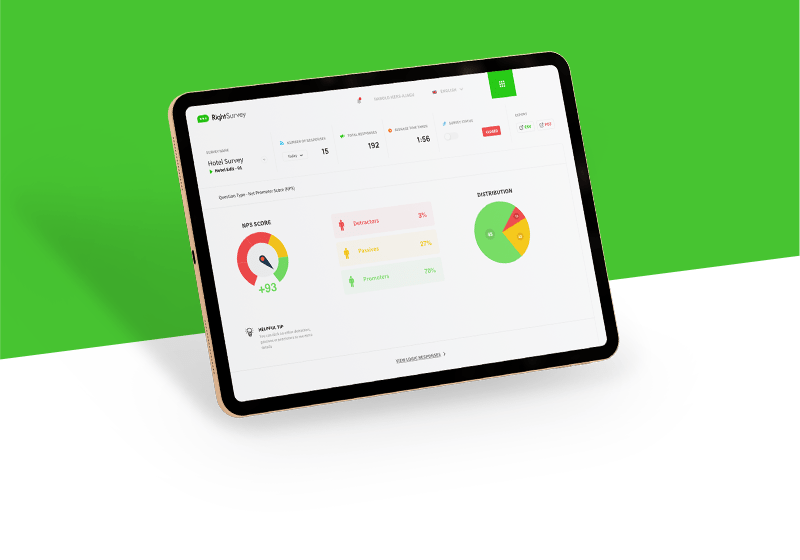NPS is a benchmarking tool for customer satisfaction. The NPS method, which is based on a two-minute survey, gives insights about customer loyalty by measuring customers’ willingness to recommend a business to a friend or acquaintance. Businesses can assess their customer service quality using the Net Promoter Score, especially in comparison to their competitors. Businesses can utilize their Net Promoter Score to resolve any shortcomings, enhance customer satisfaction, track trends in customer loyalty, and increase revenue through referrals and up-sell.
The NPS differs from other related benchmarks, such as the customer satisfaction score, by indicating a customer’s general sentiment about a brand as opposed to their opinion on particular interactions or purchases. Because of this, it crops up frequently in discussions about customer experience.
In addition, the net promoter score is a standard benchmark used by companies worldwide. This makes it a good way for businesses to gauge their performance as compared to their competitors.
What is the Net Promoter Score?
The Net Promoter Score, or NPS, is a benchmarking tool for customer satisfaction. The NPS methodology, which is centered on a two-minute survey, measures customers’ likelihood to recommend a business to a friend or acquaintance and provides insights about customer loyalty. NPS is calculated by subtracting the percentage of detractors from the percentage of promoters. The higher the percentage of promoters, the more loyal the customers and the better the business. The method is based on the idea that promoters are more likely to stay with the business, and that they are more likely to be a source of referral. Net Promoter Score presents customers with a simple survey, then feeds their answers into a formula to produce a single figure for benchmarking
How to Calculate Net Promoter Score
To calculate the Net Promoter Score, first the business asks the customer to rate the business on a 0–10 scale. Next, the business divides the customer’s rating into three groups: promoters, passives, and detractors. Promoters are customers who rate the business with a 9 or 10. They are believed to be more inclined to engage in activities that produce value, including making larger purchases, continuing with the business for a long period of time, and making more recommendations. Passives are customers who rate the business with a 7 or 8. They are regarded as being only slightly fulfilled. They might continue to support the brand, but they also have the potential to turn to a competitor if the situation is favorable. They won’t go out of their way to recommend your business to prospects. Dissatisfied customers are those who rate the business with a score of 0–6. They are (generally) actively unsatisfied consumers who could undermine the reputation of your company through slanderous reviews, engagement on social media, or word-of-mouth.
After differentiating your customers into promoters, passives, and detractors, you would have to subtract your percentage of detractors from your percentage of promoters to arrive at a Net Promoter Score.
A sample NPS calculation
Let’s imagine a scenario where a company surveys 100 000 of its customers with the standard NPS question.
After the responses are totalled, 60,000 of the respondents are promoters, 28 000 are passive, and 12 000 are detractors. The first step is to calculate these amounts as percentage values.
After obtaining all your percentage values, apply the NPS formulae: % Promoters – % Detractors = 60 – 12 = 48
The interpretation of the NPS score is somewhat complex. However, according to global NPS standards, a score of above 50 is good, and above 70 is outstanding.
After NPS has been calculated, it is now up to the management of the business to utilize the data obtained to help improve the company. After all, data is only good depending on how you use it. Management can now examine the net promoter score in further detail and aim at improving the NPS score since it has a connection with revenue.
Is the Net Promoter Score useful in business?
The Net Promoter Score is a metric that is important for businesses because it gives a company a gauge of customer satisfaction, loyalty, and willingness to recommend the company. This metric is important for businesses because it generates actionable insights about customer strategy and customer experience. The Net Promoter Score is a benchmarking tool for customer satisfaction. This metric helps businesses understand the level of customer satisfaction. A company can compare the Net Promoter Score against other companies in the industry to see how they are doing. This is a benchmarking tool that helps companies figure out how they are doing in terms of customer satisfaction.
Conclusion.
The Net Promoter Score is a benchmarking tool for customer satisfaction. It was pioneered by Fred Reichheld, who developed the concept to measure customer loyalty by measuring customers’ willingness to recommend a business to a friend or acquaintance. The Net Promoter Score is a metric that is based on a two-minute survey that asks a customer to score their willingness to recommend a business on a 0–10 scale. On a scale of 0–10, a customer is asked to rate their likelihood of recommending the company to a friend or acquaintance. Customers who give the company a score of 9 or 10 are considered “promoters” of the company, while those who give the company a score of 0 are considered “detractors.” The Net Promoter Score is calculated by subtracting the percentage of detractors from the percentage of promoters. The Net Promoter Score metric is widely used by firms of all sizes and in a variety of industries. The metric is also widely used in marketing, customer service, and sales. Research has found that the Net Promoter Score metric has a high correlation with financial performance (read our free ebook on The ROI of Customer Experience in a Post-pandemic World). The Net Promoter Score is a benchmarking tool for customer satisfaction.
Let’s have a recap of all that we have read:
- What is Net Promoter Score (NPS)? It is a benchmarking tool for customer satisfaction that is based on a two-minute survey and gives insights about customer loyalty by measuring customers’ willingness to recommend a business to a friend or acquaintance.
- How is the Net Promoter Score calculated ? This is simply the difference between the percentage of detractors and the percentage of promoters.
- Why is it important to measure Net Promoter Score? It helps companies properly circumvent their customer service strategies and grow revenue.
- What is a good or bad Net Promoter Score? According to global NPS standards, a score of above 50 is considered good, and above 70 is outstanding.




